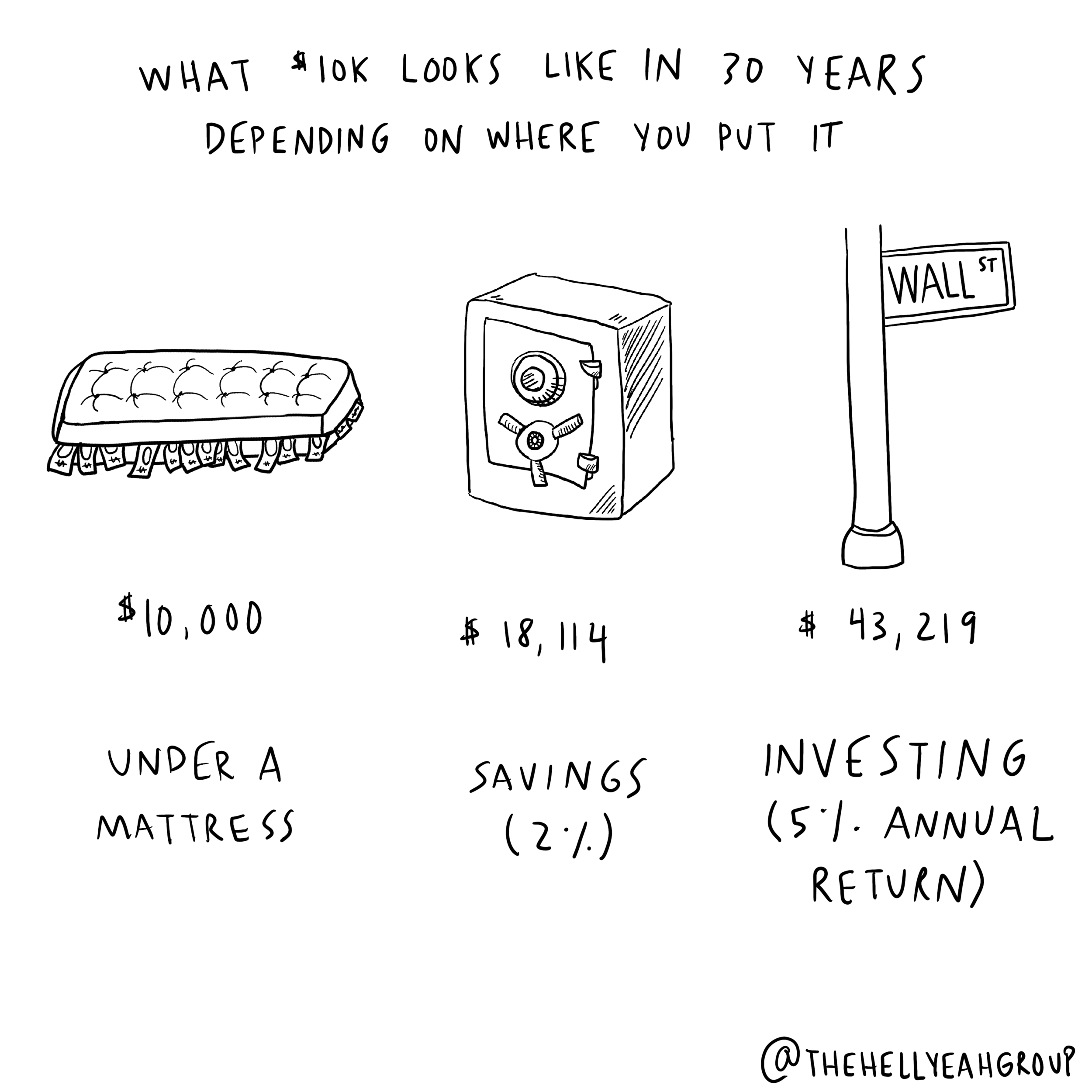Photo by John Fornander
How many times have you thrown a penny away? Like you saw a penny on your desk, or you got it as a change, and instead of putting it in your pocket to use later, you throw it in the actual garbage? I'm not trying to judge you; I'm just trying to illustrate how the penny has lost its value over time.
In 1909, you could buy a copy of the New York Tribune for one cent. And in 1932, you could travel a mile in Southern Railway System. And I'm sure you might have heard a grandparent speak of buying candy at a local five-and-dime for a penny.
How does a penny go from getting you an entire newspaper to being so annoying that you'd rather throw them away than carry them around?
When money becomes less valuable, it's usually due to inflation.
Inflation is when the price of things goes up over time which in turn, makes the value of money go down over time. Inflation or the rate of inflation is expressed as a percentage. For example, the price of burritos can go from $2.50 in 2018 to $2.65 in 2019. That's a 6% increase in price.
Inflation can feel like a sinister force because as it increases, it means your money is less valuable. The same amount of burrito costs more year over year. But most experts will agree that a little bit of inflation is good for economic growth. Deflation occurs when the prices of goods and services begin to fall. Usually, this happens after an economic downturn. Too much deflation can push the economy into a deeper and more severe crisis. It'd be like if the cost of your labor went down from $25/hour to $17/hour. In the first year, it would hurt, but if it went back up, you could bounce back. Long-term stagnation would cause more significant problems, and you'd need a longer time to recover from them.
How Does Inflation (and Deflation) Get Measured?
As hilarious as it would be only to measure inflation in the cost of burritos, that's not exactly how it works. In the U.S. inflation is measured by U.S. Bureau of Labor Statistics. They use something called the Consumer Price Index. The index collects its data from surveying 23,000 businesses and records the prices of 80,000 consumer items each month. That is how the CPI aggregates data to give us the general rate of inflation. Yes, CPI is not a perfect measure, but there are rarely ever are perfect measures.
What Causes Inflation?
There are a few things that impact and cause inflation. There is something called demand-pull inflation. That's when something is in such high demand that the supply of the goods or services cannot keep up, and as a result, consumers are willing to pay a higher price. There are quite a few things that can create this type of inflation:
a growing economy,
the expectation of inflation that causes demand to increase at the current price, which in turn causes inflation,
when the Fed enacts monetary policy that puts too much money in the money supply,
a brand that is so awesome that it increases demand,
fiscal policy that increases government spending and
technological innovation.
Cost-push inflation is another type of inflation. That's when demand stays the same, but the supply is constrained. You'll see this with natural resources like oil and gas. If the supply gets limited, but demand remains the say, the cost will get pushed up.
How to Protect Yourself and Your Money Against Inflation
Option 1: Opt Out of Modern Living
Join a cult, convent, or seminary. Become a monk. Live life on the road as a hobo. Beat inflation via exchange-rate arbitrage by living in a country that has a much lower cost of living while still getting paid wages from clients, customers, or an employer that pays developed-world wages. These options are not for everyone, but they are not out of the realm of possibility. Either way, opting out of modern living is probably quite an adjustment.
Option 2: Make Sure Your Income Grows Each Year
A more socially acceptable way to protect yourself against inflation is to make sure your earnings and income grow at the same pace or a higher pace than inflation. For example, if the rate of inflation was 2.5% last year and you get a 5% raise, your income is growing at a higher rate than inflation is. In other words, your income is keeping pace with inflation. Not everyone has been able to stay ahead of inflation. Wages have stagnated while the cost of living has increased. So folks struggle to keep up with this increase have had to take on additional jobs or created their businesses. The latter is what I did when I realized that I needed to increase my income drastically.
Option 3: Invest Your Money
I don't give investment advice. That statement is both a disclaimer and a personal preference. I do, however, drop (investment) knowledge.
I'm sure you already know what investing is, but in case you need a refresher, here it is. Investing is when you allocate money towards achieving a profit or a return. In other words, you take a risk with your money in an attempt to earn more money. You might hear people refer to investing along the lines of "having their money work for them."
To further shape what investing is, I'll tell you what it isn't. Investing isn't short-term savings, and it isn't picking and trading stocks. Short-term savings typically aren't invested because it's too much risk for cash that you may need access to very soon. Picking and trading stocks are a lot riskier than long-term investing.
With long-term investing, the goal should be to save money for the future.
Let's say you save $10,000 in cash today, and you keep it in a high-yield money market savings for 30 years. Let's say you get a 2% return each year. You'll probably get a few hundred bucks every year, and after 30 years, you'll have about $18,114. Awesome! Until you compare that with investing. Let's say you invest $10,000 today and you get a 5% return each year. In 30 years, you'll have about $43,219.
Yes, when you invest, you are taking a risk, but it's important to remember that inflation will almost always outpace the interest rates. Investing is all about the relationship between risk and reward. To balance that relationship, it's essential to:
Understand the risk you're taking - there is no reward without risk.
Have a goal for what the future money is for and invest according to that goal. Make sure you're taking on the right kind of risk, given your goals and timeline. Investing over 30 years for retirement will look different than investing for 18 years toward a college fund.
You are diversifying your investments instead of putting all your eggs in one basket.
Taking right financial risks by knowing how much risk you are willing to take.
Investing Considerations
Before you go balls deep investing every cent you have, please consider a couple of things.
If you have a lot of high-interest credit card debt, you might want to attack that balance before putting away large sums of money into an investment account. If you're paying 19.24% in interest, you want to knock that out as quickly as possible. Otherwise, depending on your balance, you could spend tens of thousands of dollars in interest over many, many years.
If you don't have an emergency fund, you might not want to invest large sums of money.
However, I think it's essential to start investing as early as possible, even if it's only a small amount of money. It's a great habit to build.
If you're ready to jump into investing and you're looking for a platform. Here are some to get you headed in the right direction:
Betterment - Low cost, easy-to-use, roboadvisor platform
Wealth Simple - Another low-cost, easy-to-use robo advisor platform
Vanguard - A more classic investment platform with more access to different types of investment vehicles




